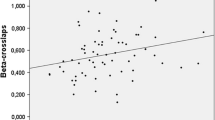Abstract
Background
Most of the alkaline phosphatase (ALP) isoenzymes are derived from the bones and liver. High levels of ALP are often encountered during routine blood investigation in elderly patients. However, because ALP includes various isoenzymes from other tissues, an accurate diagnosis is usually not possible on the basis of elevated ALP alone.
Aims
To identify the cause of increased ALP in postmenopausal women.
Methods
We measured serum ALP in a group of 626 postmenopausal osteoporotic women before and after treatment with a bisphosphonate (either alendronate or risedronate). We analyzed the correlations between ALP levels and bone metabolic markers or hepatic function markers.
Results
The ALP and BAP levels of people in their 80s were significantly higher than those of people in their 60s. With bisphosphonate therapy, the BAP decreased, and the elevated ALP decreased to normal range levels. ALP was highly and significantly correlated with BAP both before and after treatment. The changes in levels of ALP correlated well with the changes in BAP levels before and after bisphosphonate therapy. Markers of liver function correlated with total ALP (p < 0.01), but the correlation was much smaller than that between ALP and BAP.
Discussion
Bisphosphonate treatment lowered ALP levels, and this decrease was strongly correlated with a decrease in BAP. Among blood test data, the decrease in BAP had the strongest correlation with the ALP decrease.
Conclusion
For treatment of osteoporosis, ALP is an acceptable alternative to BAP. Elevated ALP in postmenopausal women is mainly caused by high bone turnover.


Similar content being viewed by others
References
Fleisher GA, Eickelberg ES, Elveback LR (1977) Alkaline phosphatase activity in the plasma of children and adolescents. Clin Chem 23:469–472
Cheng MH, Lipsey AI, Blanco V, Wong HT, Spiro SH (1979) Microchemical analysis for 13 constituents of plasma from healthy children. Clin Chem 25:692–698
Cherian AG, Hill JG (1978) Age dependence of serum enzymatic activities (alkaline phosphatase, aspartate aminotransferase, and creatine kinase) in healthy children and adolescents. Am J Clin Pathol 70:783–789
Whitaker KB, Whitby LG, Moss DW (1977) Activities of bone and liver alkaline phosphatases in serum in health and disease. Clin Chim Acta 80:209–220
Statland BE, Nishi HH, Young DS (1972) Serum alkaline phosphatase: total activity and isoenzyme determinations made by use of the centrifugal fast analyzer. Clin Chem 18:1468–1474
Schiele F, Henny J, Hitz J, Petitclerc C, Gueguen R, Siest G (1983) Total bone and liver alkaline phosphatases in plasma: biological variations and reference limits. Clin Chem 29:634–641
Gardner MD, Scott R (1978) Frequency distribution and ‘reference values’ of plasma alkaline phosphatase (EC 3.1.3.1) activity in the adult population of a Scottish new town. J Clin Pathol 31:1202–1206
Kelly A, Munan L, PetitClerc C, Plante G, Billon B (1979) Patterns of change in selected serum chemical parameters of middle and later years. J Gerontol 34:37–40
Nishida T (2001) Age changes of clinical laboratory test result. Rinsho-Kensa 45:353–358
Orimo H, Hayashi Y, Fukunaga M, Sone T, Fujiwara S, Shiraki M et al (2001) Diagnostic criteria for primary osteoporosis: year 2000 revision. J Bone Miner Metab 19:331–337
Endo N (2007) A definition and the diagnostic criteria for osteoporosis
Orimo H (2006) Guidelines for the prevention and treatment of osteoporosis 2006
Iino S (1995) Biochemical test including isozymes, alkaline phosphatase (ALP). Nippon-Rinsho 53:276–279
Kuwa K (1993) A trend of the enzyme test standardization. Rinsho-Kensa 37:473–478
Kuwana T, Sugita O, Yakata M (1988) Reference limits of bone and liver alkaline phosphatase isoenzymes in the serum of healthy subjects according to age and sex as determined by wheat germ lectin affinity electrophoresis. Clin Chim Acta 173:273–280
Gallagher JC, Kinyamu HK, Fowler SE, Dawson-Hughes B, Dalsky GP, Sherman SS (1998) Calciotropic hormones and bone markers in the elderly. J Bone Miner Res 13:475–482
Dresner-Pollak R, Parker RA, Poku M, Thompson J, Seibel MJ, Greenspan SL (1996) Biochemical markers of bone turnover reflect femoral bone loss in elderly women. Calcif Tissue Int 59:328–333
Woitge HW, Scheidt-Nave C, Kissling C, Leidig-Bruckner G, Meyer K, Grauer A et al (1998) Seasonal variation of biochemical indexes of bone turnover: results of a population-based study. J Clin Endocrinol Metab 83:68–75
Nishizawa Y, Nakamura T, Ohta H, Kushida K, Gorai I, Shiraki M et al (2005) Guidelines for the use of biochemical markers of bone turnover in osteoporosis (2004). J Bone Miner Metab 23:97–104
Takahara K, Kamimura M, Nakagawa H, Uchiyama S (2004) Changes in biochemical markers of bone in patients with insufficiency fractures. J Bone Miner Metab 22:618–625
Takahara K, Nakagawa H, Kamimura M, Hashidate H, Kawaguchi A, Uchiyama S (2004) Unusual stress fracture of the femoral neck in a young adult not caused by excessive stress: a case report. J Orthop Sci 9:650–653
Hosking DJ (1978) Changes in serum alkaline phosphatase after femoral fractures. J Bone Joint Surg Br 60:61–65
Ingle BM, Hay SM, Bottjer HM, Eastell R (1999) Changes in bone mass and bone turnover following distal forearm fracture. Osteoporos Int 10:399–407
Nakagawa H, Kamimura M, Takahara K, Hashidate H, Kawaguchi A, Uchiyama S et al (2006) Changes in total alkaline phosphatase level after hip fracture: comparison between femoral neck and trochanter fractures. J Orthop Sci 11:135–139
Kamimura M, Uchiyama S, Takahara K, Hashidate H, Kawaguchi A, Nakagawa H (2005) Urinary excretion of type I collagen cross-linked N-telopeptide and serum bone-specific alkaline phosphatase analysis to determine the correlation of age and back-pain related changes in elderly women. J Bone Miner Metab 23:495–500
Conflict of interest
There are no conflicts of interest or support to declare regarding this work.
Author information
Authors and Affiliations
Corresponding author
Rights and permissions
About this article
Cite this article
Mukaiyama, K., Kamimura, M., Uchiyama, S. et al. Elevation of serum alkaline phosphatase (ALP) level in postmenopausal women is caused by high bone turnover. Aging Clin Exp Res 27, 413–418 (2015). https://doi.org/10.1007/s40520-014-0296-x
Received:
Accepted:
Published:
Issue Date:
DOI: https://doi.org/10.1007/s40520-014-0296-x



